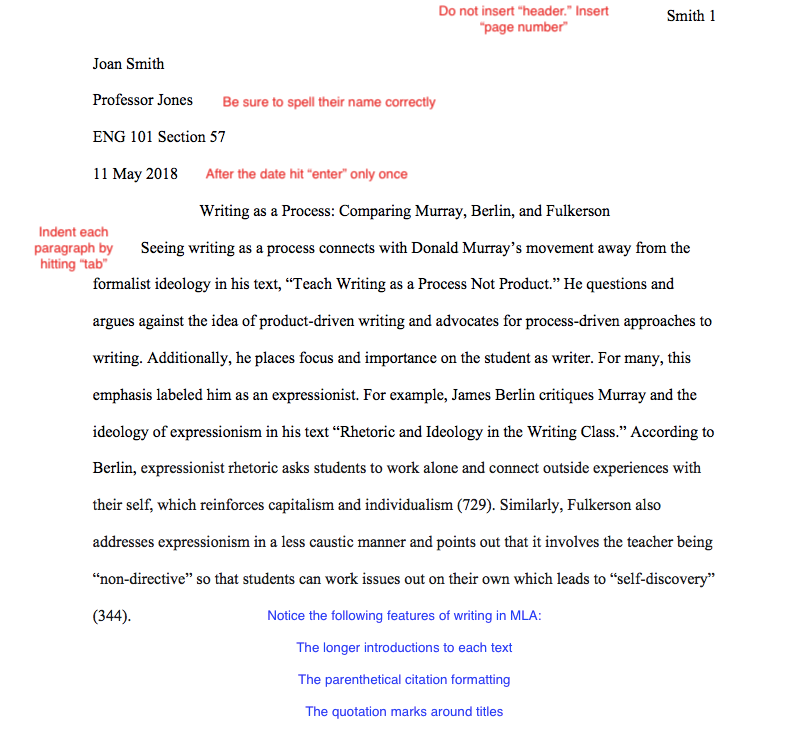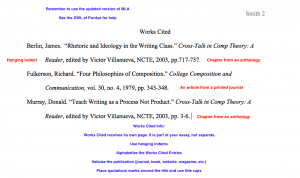MLA and APA Documentation
There are many types of documentation styles; however, the two you will use most consistently in college writing classes are MLA and APA. You might think that it doesn’t matter which one you choose, but it does.
A documentation style dictates how a manuscript is formatted, the way you cite outside sources inside the text (signal phrases and parenthetical citations), the way you cite bibliographic information (Works Cited or References), and the style of writing that you use.
For this course, you will be formatting your papers and your citations using MLA Style.
Modern Language Association (MLA)
The Modern Language Association began in 1883 as a “discussion and advocacy group for the study of literature and modern languages” (“Modern Language Association”). The style was created by this group in 1951 in order to provide scholars in this field with a set of shared writing and citation guidelines. MLA is mostly used in the humanities such as English and modern languages. You will likely also use MLA formatting in history courses.
MLA style is simplified, compared to some of the other styles. MLA does not use cover pages, headings, or footnotes. The manuscript style reflects the types of essays written in the humanities.
Essays and articles in the sciences and social sciences often use distinct sections that do not necessarily transition seamlessly. In a scientific journal article, for instance, one would expect to see an abstract, a summary of the experimental data, and an analysis of the data. There is less expectation to connect those parts with transitional elements, as scientific writing relies on clear headings an labels.
In the humanities, however, academic writing looks more like the essays you will write for this course. Writers addressing audiences in the humanities create arguments that build throughout the essay. In the humanities, writers are expected to use transitional elements to connect parts of the argument and paragraphs seamlessly.
Because academic writing in the humanities places value on written arguments that build throughout the essay, there is no need for headings or subheadings.
For more help with MLA please visit the OWL of Purdue’s MLA Guide.
MLA Format Requirements:
Font:
Your font should be a consistent size throughout the essay. Follow the specific formatting guidelines specified in the assignment.
If no formatting is specified, you should select either Times New Roman 12 pt or the default font for your word processor. In Microsoft Word, the default is Calibri 12pt. For Google Docs, the default font is Arial 11pt.
Do not attempt to use a larger or more creative font. Your essay will look different from the others and stand out for the wrong reasons.
Margins:
Use one-inch margins around the entire page.
Most word processing programs will have a default setting of one-inch margins, but check your settings before writing. Larger margins will make it appear that you’re trying to submit an essay that doesn’t meet length requirements.
Spacing:
The entire manuscript should be double-spaced. There should not be extra spaces around your heading or title. There should not be extra spaces between paragraphs or between items in your Works Cited page.
Including extra spaces is a signal to your professor that you either don’t understand correct formatting style, don’t care, or you are trying to make your essay appear longer.
If you are using Microsoft Word, you will need to check your paragraph settings. Some versions of word insert an additional space after each paragraph. Students need to remove this setting. This website shows the process for removing those spaces: https://academicanswers.waldenu.edu/faq/323167. Depending on your version of MS Word, you may need to search for more specific instructions.
Indentation
MLA formatting uses traditional paragraph indenting. When starting a new paragraph, use the TAB key on your keyboard to indent the first line 0.5 inches. Do not use the space bar.
For the Works Cited page, MLA uses hanging indents. These need to be formatted in your word processes. You should not try to use the TAB key to create them.
Page Numbers
MLA formatting requires writers to include page numbers in their document. Page numbers should be placed in the header of the document. Include your last name to the left of the page number.
Example of MLA Format
Below is an annotated example of other important features you should include when formatting your essays in MLA Style. In a later chapter, we will cover the specific information about MLA citations.


